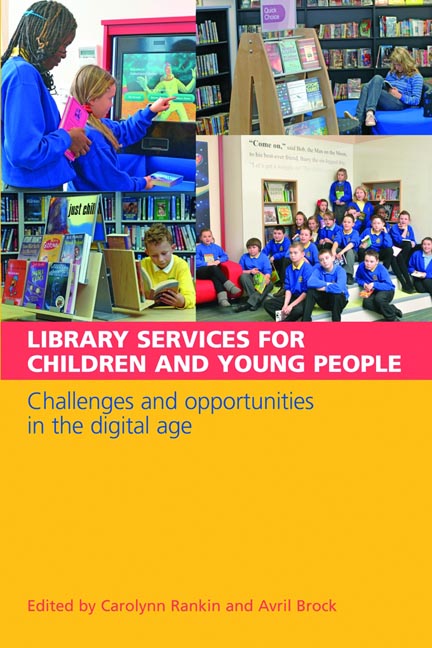Book contents
- Frontmatter
- Dedication
- Contents
- Contributors
- Foreword
- Acknowledgements
- Introduction and vision for the book
- Part 1 Children's library services – policy, people and partnerships
- Part 2 Connecting and engaging – reaching your audience and catching the latest wave
- Part 3 Buildings, design and spaces – libraries for children and young people
- 11 Library space and place transformation – designing for the digital natives
- 12 Making space for reading – designing library spaces for children in public and school libraries
- 13 Case study. Imagine, explore, discover – welcome to The Trove at White Plains Public Library, New York
- Part 4 Issues for professional practice
- Index
12 - Making space for reading – designing library spaces for children in public and school libraries
from Part 3 - Buildings, design and spaces – libraries for children and young people
Published online by Cambridge University Press: 08 June 2018
- Frontmatter
- Dedication
- Contents
- Contributors
- Foreword
- Acknowledgements
- Introduction and vision for the book
- Part 1 Children's library services – policy, people and partnerships
- Part 2 Connecting and engaging – reaching your audience and catching the latest wave
- Part 3 Buildings, design and spaces – libraries for children and young people
- 11 Library space and place transformation – designing for the digital natives
- 12 Making space for reading – designing library spaces for children in public and school libraries
- 13 Case study. Imagine, explore, discover – welcome to The Trove at White Plains Public Library, New York
- Part 4 Issues for professional practice
- Index
Summary
Introduction
Libraries have a long and proud tradition of providing services for children. In the UK, a library card is a child's first public expression of independent participation as a citizen in a local democracy; on all other formal papers, a child is an appendage to an adult, but a library ticket carries the child's own name and can be used without adult support. Library staff were also among the first to address the child directly, not their accompanying adult, and the library was established early on as a safe space for a young child to make an independent journey to. It was quite normal, as a child in the early 1960s, for me to make a three-mile bus trip to the library by myself on a Saturday morning, from the age of eight.
When I began working in public libraries in the 1980s, I found a tradition of active intervention in working with children, which was not part of adult library work, until the influence of reader development in the 1990s. Staff saw their role as active and developmental – engaging with individuals and helping them move forward, not just providing materials and leaving customers to find their own way. This meant lots of group activities – reading aloud, craft sessions – as well as engaging with individual children about their reading choices. In many places there was an articulated understanding of an open value system; everyone knew that if a child expressed enthusiasm for a popular format, whether superheroes or pony books, this should be met with encouragement and not disapproval. The approach should always be ‘and have you seen this as well?’, not ‘why don't you read this instead?’
With book issues on the increase and children's publishing booming, should we expect that children's libraries are safe to continue and grow, on the assumption that their place in culture and community is assured? This chapter will argue that radical shifts in thinking and practice are needed, in order to keep children's libraries as relevant and valued in the next 30 years as they have been in the last 30 years.
Information
- Type
- Chapter
- Information
- Library Services for Children and Young PeopleChallenges and opportunities in the digital age, pp. 183 - 198Publisher: FacetPrint publication year: 2012
